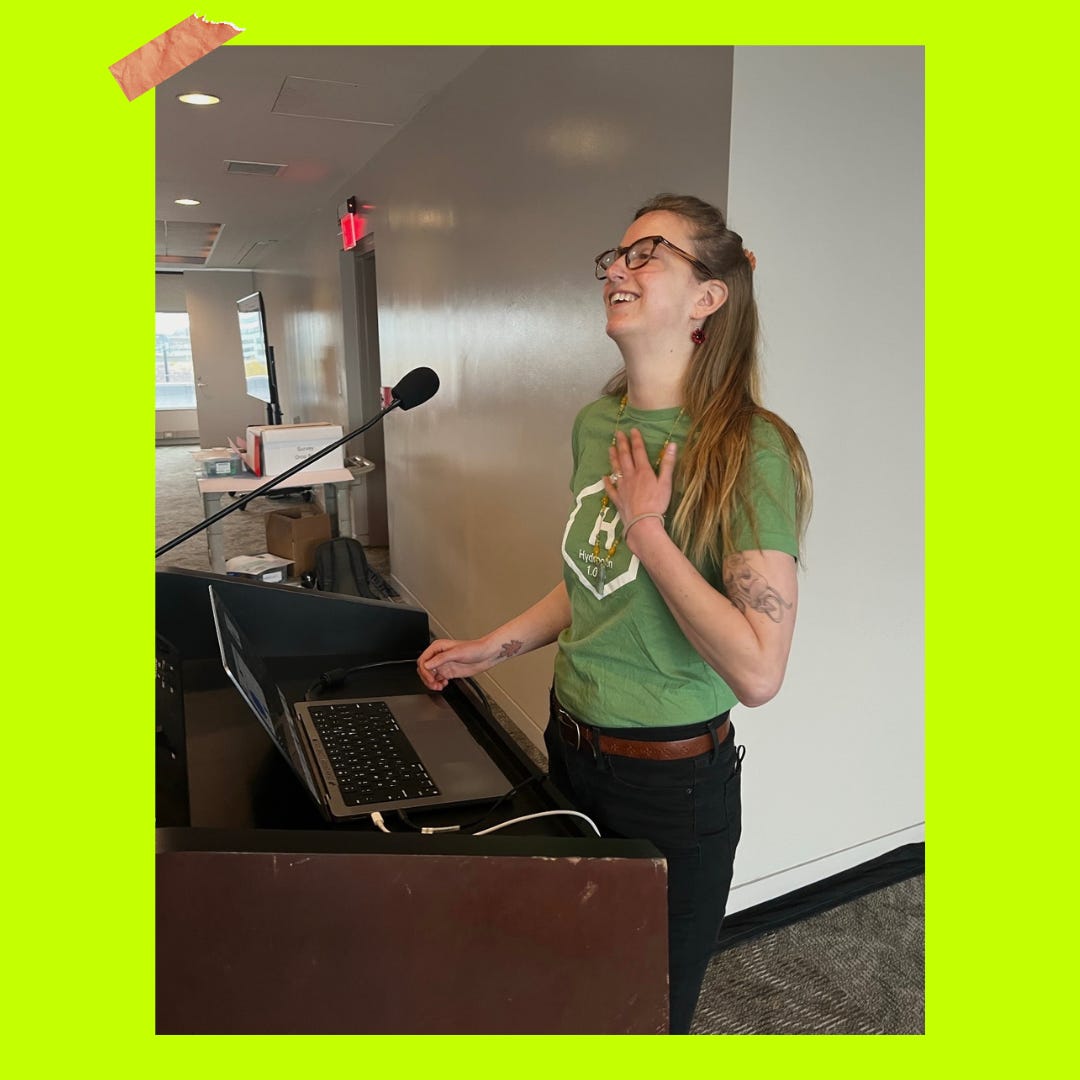Laid Off: Department of Energy's Hydrogen Technology Community Engagement Lead
"Now, because they used the terms 'CBPs,' 'DEI,' and 'environmental justice,' no one can access these resources that fundamentally equip communities to understand clean energy technologies."
Laid Off is the coolest place on the internet to talk about being laid off. Wanna partner? Have a tip? Hit reply.
Gentle reminder: Laid Off is kept afloat by paying subscribers who support the work. If you like this newsletter and have the means — I understand a lot of my reader base recently lost their jobs, and that’s why most of the issues are free — consider becoming a paid subscriber. At $5/month, that’s like one fancy coffee a month. Or the delivery fee on your DoorDash order. Or an impulse lip balm purchase at CVS. I appreciate you.
In today’s issue, I talk to Emily Loker, a former workforce and community engagement lead in the Hydrogen and Fuel Cell Technologies Office at the Department of Energy. Loker was among the thousands of federal workers abruptly laid off by the Trump administration.
From the first day of Trump’s presidency, Emily Loker was fairly certain she would be laid off.
Emily, 33, worked in community and workforce engagement in the Hydrogen and Fuel Cell Technologies Office at the Department of Energy (DOE). She had been working there for nearly two years.
The first few weeks of Trump’s term, all of the work Emily and her colleagues had done to expand benefits to all Americans was eliminated. That included educational resources and funding dedicated to community engagement and workforce development.
During the second week of his term, Emily’s team received a “fork in the road” email that said they had a week to decide if they wanted to resign with full pay until September. “I was not quitting a job I loved, so did not consider the offer.”
Two weeks later, on February 13, 2025, DOE leadership told Emily’s supervisors to pass down to probationary workers that their jobs were tenuous. Later that same week, Emily’s supervisor texted her that she’d heard another office’s probationary workers had already been laid off.
That same day, a coworker texted Emily an E&E news article reporting that “most or all” of probationary staff at DOE would be laid off that day. She got home, and her supervisors called her crying, confirming the news. Emily would be among those laid off.
“We then had an all-hands meeting where the person convening proceeded to call layoffs ‘normal and impersonal’ and compared our layoff to the auto industry,” she said. “These comparisons felt ridiculous considering the federal government has long been considered a very stable place to work and many people choose to be civil servants for the mission and stability over larger salaries in the private sector.”
Emily and her colleagues spent the final two hours of their workday saying virtual goodbyes, expressing their gratitude for each other, and “frantically” gathering important files off their work computers.
At 9:30pm ET, she got a form letter terminating her employment.
What reasoning did they give for laying you off?
I received a form letter — the exact same letter my eight colleagues received — noting that our service was "no longer in the public's best interest." Considering my service was dedicated to maximizing research funding to all Americans through workforce development, education, DEI (diversity, equity, and inclusion), and community engagement, I did not believe them.
Where were you when you found out?
I was first running errands. I was in a parking lot trying to jump my car battery.
What was the first thing you did after receiving the news?
I downloaded my personnel folder from the government portal. The personnel folder contains important documents like salary information and performance reviews.
Can you describe some of the work that you did for the Department of Energy that some people might not be familiar with or understand the importance of? What will be missing or at risk now that you and your peers are no longer there?
Under the Biden/Harris Administration, environmental and energy justice was a priority. I worked in a clean energy technology office (hydrogen) that did research that may never reach commercialization. That means that much of the research we fund, may never have direct benefit to the American public.
In 2022, DOE created community benefits plans (CBPs) requirements. I supported embedding programs like CBPs into our office's work and amplified the importance of hydrogen community engagement and education. In simple terms, I led efforts in our office to put humans and human benefits at the center of the office's technology work. This supported the technologies being more responsive to community concerns and, in the long term, better for both people and planet. Now that my role no longer exists in my office, the human dimensions of science research will no longer be as much at the fore of the office's work. As a coworker reflected to me after I was fired, "I miss being reminded by you of why our work matters."
Through your work with the DOE, you published web resources, including an environmental justice strategy. You noted that these resources have since been removed. Can you expand on that work, and the effects of taking down the resources from the website? Why do you think they were removed?
My approach towards public resources was transparency and accountability. Many conversations happened about environmental justice and we talked about its importance daily during the Biden/Harris Administration. But the public wasn't necessarily aware of all that work behind the scenes. By publishing our strategy, we were stating for public viewing what our plans were to support hydrogen justice.
The effects of taking the resource down are multifaceted. First, it eliminates the public's ability to engage with our office about our environmental justice work, which is currently not happening due to executive orders. Second, it eliminates important history and resources people could access and still use even though we were not actively promoting it. For example, during my time, I supported a cross-office effort to develop public forums on CBPs and on hydrogen and environmental justice. These forums were creative commons licensed and anyone could hold a forum anywhere in the world. Now, because they used the terms "CBPs," "DEI," and "environmental justice," no one can access these resources that fundamentally equip communities to understand clean energy technologies and how they could potentially maximize the benefits of these technologies.
You described the abrupt removal of federal employees as a "frightening dismantling of our democracy from the inside." What are some of the immediate implications dismantling the DOE has on our country that you hope people will understand?
Each person fired without cause and illegally has a story. Their work had direct and indirect benefits to the American public. Each person fired is also a person trying to serve the public and to meet their basic needs as a human being. Being fired, without cause, without warning, and without compensation, is inhumane. I have heard stories of people being without insurance for their cancer treatment. People losing their housing when it was connected to their jobs. People needing to move back in with their relatives because they were already living paycheck to paycheck on their government salaries. And now, because we were not given adequate notice or severance, many of us are relying on the systems this Administration is looking to use to fund tax breaks for billionaires. Immediately when I was fired, I applied for Medicaid because I will lose insurance in 31 days and SNAP because I no longer receive a paycheck to cover basic expenses.
Have you been talking to your DOE peers who were also laid off?
Yes, I have been in contact with the other people who were fired. There are a range of emotions and experiences. Many of us are in grief over losing jobs we loved. Having trauma responses from being fired in an inhumane way. Some people are moving quickly to secure other jobs because we are told many more federal layoffs are forthcoming.
What about conversations with people still there? Do you have any sense of the vibe there right now post-layoffs?
I don't want to share anything that could put my colleagues' jobs in jeopardy. They hosted a happy hour for the four of us laid off in the Golden Office and there was a lot of sadness at the change in office culture the office experienced after having 20% of the office laid off in one day.
There are legal, psychological and economic impacts to laying thousands of people off in a matter of days.
Emily is actively seeking opportunities in community engagement, organizational change, and community-driven energy projects. You can reach her on LinkedIn.












Hi Melanie - Do you have any submissions from individuals over 50+ to share with your readers?
Read about your Substack on CNBC this morning. I immediately subscribed. Thank you for doing this!